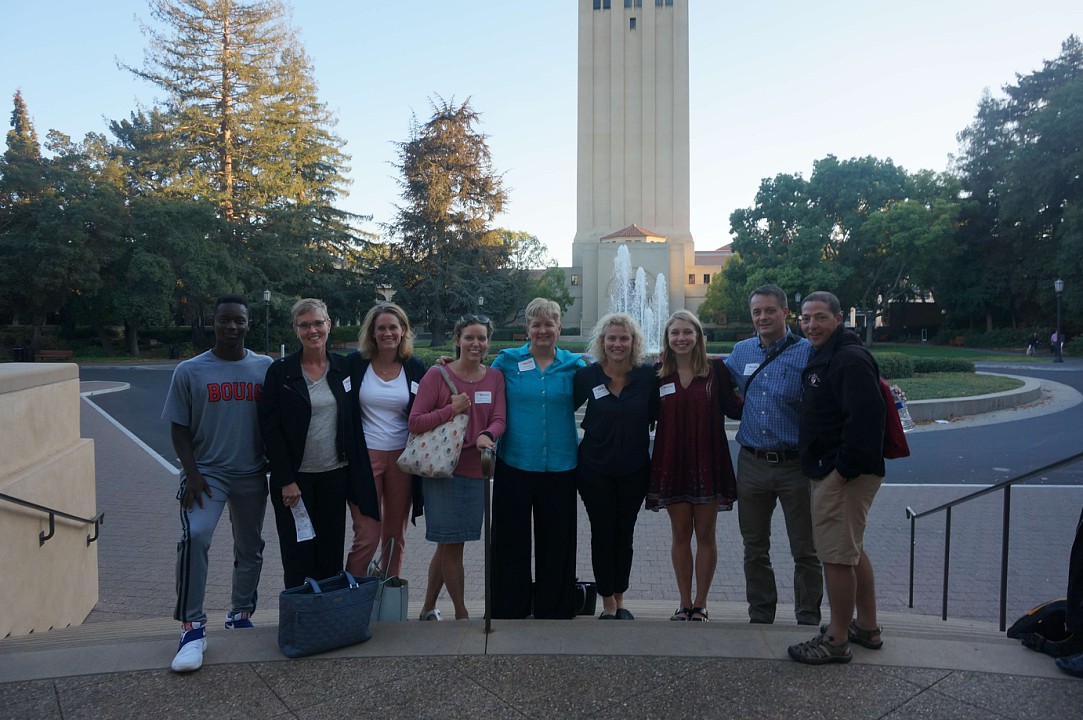A version of this article appeared on print in our November 2016 issue.
I wish I had counted the number of times people asked me “What did you do on your trip to California?” Never in my life have so many people been genuinely interested in how I spent my long weekend. So, here are all your answers, curious inquirers. Here’s your one stop shop to all things Challenge Success.
Our hodgepodge group of teachers, administrators, and students (two of us) met Thursday afternoon on September 29 at Logan to board our late-night flight to San Francisco. From the Virgin America terminal, we kicked off the three-day trip.
The conference began Friday afternoon with introductions for schools, like us, new to the program. Aside from the 15+ new schools attending the conference, Challenge Success has worked with over 130 other schools across the country — ranging from president Barack Obama’s private school alma mater in Hawaii to our neighbors in Dover-Sherborn.
Innovating teachers at Stanford University’s School of Education came together in 2007 after noticing the lack of emotional and academic well being in students at neighboring California high schools. They saw that students had stopped learning for the sake of learning and instead fulfilled their assignments just for the grade or to get into the best college. This mentality doesn’t lend itself to a particularly happy high school experience; in fact, it provides the basis for depression, anxiety, and other mental illnesses in students.
Education research proves that this mechanical way of going through school without true engagement prevents students from truly learning the material and the life skills schools intend to teach. Challenge Success’s founders realized there was something backwards about this approach to school: not only does our emotional and mental well-being suffer, but so does our academic well-being. Thus was born Challenge Success, an organization which questions traditional understandings of success in school.
This core philosophy was the starting point for discussions Friday. That evening, each school gathered for a welcome presentation with keynote speaker Catherine Steiner-Adair Ed. D. on the topic of using media & modern technology to help rather than hinder student development.
Saturday held a day of breakout lessons. These “content sessions” dove into the nitty gritty of Challenge Success’s broad goals. There were workshops for teachers (for example: “Teaching for Engagement”), for parents (“A Saner View of Parenting”), and for students. I attended “Advocates for Change, a Student Session.” This was really interesting because I had the opportunity to talk to other kids who were engaging in the same sorts of discussions across the nation. We compared our schools and found similar struggles and concerns. It was eye-opening to hear that many of the schools in attendance looked a lot like Wellesley: wealthy, highly rigorous, college-centered towns and learning environments.
It made me realize that maybe there is a deeper set issue at play here. Why are all these affluent schools experiencing the same patterns?
While I don’t think I — or anyone — can answer this question yet, it remained in my mind throughout the weekend and into the meetings with our school’s individual coach.
Alisa Andrews, our Challenge Success coach, drove our conversations to tackle some of the more daunting issues Challenge Success aims to address. As a Wellesley parent herself and trained educator, she remained optimistic that these attitude changes will someday occur while simultaneously staying realistic that that day is a long way down the road.
These small, structured meetings were a time for our group of nine to dig into the roots of the issues we see and then figure out exactly what we will do about the stress, disengagement, and overall unhappiness students experience in school.
To do that going forward, our team’s first step is educating the community about our mission and our philosophy. In January, Denise Pope, one of Challenge Success’s founders will visit the high school to speak to parents, teachers, and students alike. Additionally, Challenge Success has designed a survey that assesses exactly where issues with student stress and health are the strongest. The survey, which will also take place in January, will provide us with numbers that will not only allow us to identify where we need the most change, but will also give figures to attach to anecdotes and give a face to why there is a need for an adjustment.
Once we have this survey data, we will move forward to tackle the issues we see one at a time. And, in doing so, we hope to expand our group — nine people are not nearly enough to completely change the way we address education! Not only do we have an expanded teacher and parent group, but we are also looking to establish a student advisory group to help implement the practices we see a need for in school.
The issues of student stress, mental health, and innovative education are far too broad to all be tackled at once, so the process of entirely adopting Challenge Success’s mission is nearly impossible. However, that is not what we aim to do; there are areas of the school in need of improvement and areas that can afford to remain as they are. This year, we simply aim to introduce Challenge Success’s philosophies to create a learning environment where we all thrive, emotionally and academically.


[…] speech Roy will give Monday morning falls under the umbrella of the fledgling Challenge Success program at the high school, in hopes of inspiring students to find their own paths to a meaningful […]